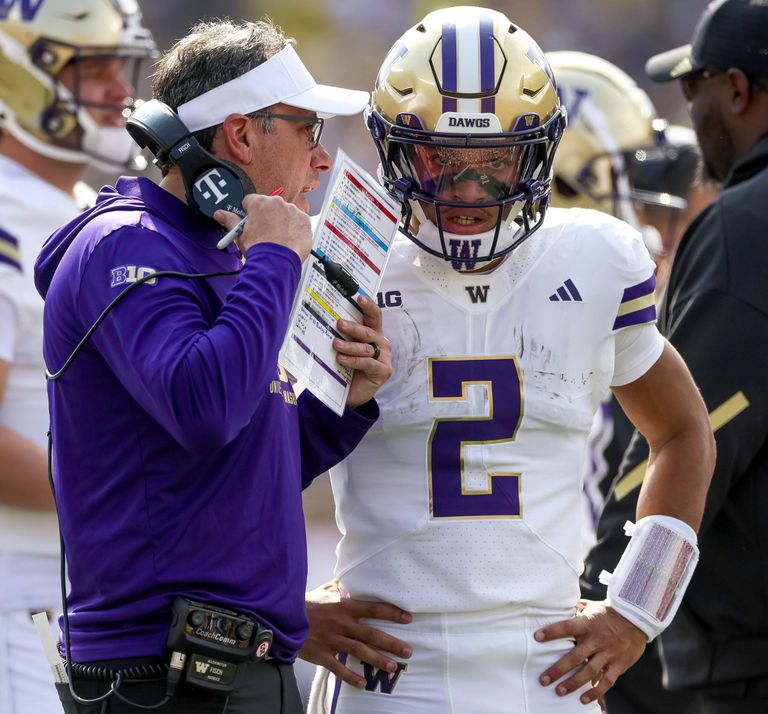How UW Huskies are trying to generate more plays in slow-paced Big Ten

By Andy YamashitaSeattle Times staff reporter
A large percentage of Jedd Fisch’s Washington tenure has revolved around adapting to the Big Ten.
Building a bigger, stronger roster, particularly along both sides of the trenches. Learning how to handle travel across multiple time zones, something the UW coach solved by leaning on some of his NFL connections like Seahawks coach Mike Macdonald. Improving and upgrading team facilities to match some of the Big Ten’s best.
Fisch, however, noted another adjustment the Huskies are having to make with five games remaining during their second season in the conference.
“The Big Ten,” he said Monday, “is certainly a different league when it comes to the amount of plays being run.”
Fisch and the Huskies are getting firsthand experience with the Big Ten’s slower pace of play. Through four conference games, the Huskies are averaging 61 plays per game. UW has been limited to fewer than 60 plays three times — during its 38-19 win against Rutgers and in losses against No. 1 Ohio State and No. 25 Michigan.
Washington continues its Big Ten campaign at 12:30 p.m. Saturday when it welcomes No. 23 Illinois to Husky Stadium.
“It’s just what the Big Ten is,” Fisch said. “It’s about 60 plays a game.”
No game has epitomized the conference’s slower pace of play like UW’s most recent game against Michigan. The Huskies (5-2, 2-2 Big Ten) ran just 55 offensive plays against the Wolverines during 10 drives.
Both teams managed just four complete possessions during the first half. Each scored a touchdown. Each missed a field goal. Neither committed a turnover, and they entered halftime tied 7-7. The lack of opportunities for both teams made Washington’s mistakes during the second half even more apparent.
Washington’s six second-half drives resulted in three interceptions, two punts and a turnover on downs. UW had five total plays during the fourth quarter, Fisch noted. It’s a notable change from the pace of play in the Pac-12, Fisch said, where he’d expect to get around 76 plays per game.
UW experienced this slower pace of play a season ago, when it averaged 64.7 plays per game during Big Ten play. And Fisch noted UW’s current amount of plays per game is similar to the NFL. The Seahawks, for example, are averaging 60.6 plays per game in 2025.
“NFL scores, that’s what we saw in most of the Big Ten games,” he said.
So how does Washington adjust to the slower pace of play? Fisch said UW can increase its plays per game two ways: converting on third down and creating turnovers.
The Huskies have been a solid third-down team in 2025, going 42 for 79 — or 53.2% — and ranking seventh nationally. However, that percentage drops steeply during conference play. They have converted just 15 of their 43 third-down attempts — or 34.9% — in Big Ten games this season. That ranks 14th in the conference, behind Purdue, Rutgers and Michigan State among others.
Offensive coordinator Jimmie Dougherty said the limited possessions in Big Ten games also means the offense needs to do a better job taking advantage of its opportunities. Washington passed Michigan’s 40-yard line four times. It walked away with one touchdown, a missed field goal and two punts after costly procedural penalties stalled out drives.
Washington’s red-zone conversion percentage has similarly fallen after its strong start during nonconference play. UW has converted 76.9% of its red-zone trips in Big Ten play, six touchdowns and four field goals, ranking 13th in the conference.
“You’ve got to make your possessions count,” Dougherty said. “Every play matters — which is always the case — but especially when you know you’re only going to get so many opportunities.”
But Fisch and defensive coordinator Ryan Walters said forcing turnovers is where Washington needs to improve the most. UW has gained eight turnovers in seven games this season, 69th nationally and around the same average it managed under former defensive coordinator Steve Belichick in 2024.
Against Michigan, Washington didn’t create a single turnover for the first time this season. Walters said the Husky defense deserved equal blame for the team’s negative turnover margin against the Wolverines as the offense.
“We didn’t provide any extra possessions,” he said Tuesday. “That’s something we continue to emphasize. We had a couple opportunities Saturday to do that and we didn’t. Got to catch the ball when it’s thrown to us. Got to be better in our zone drops. Having an awareness of where the ball is when you’re going to enter a tackle and being violent at the point of contact with the ball carrier. Things we emphasize always and will continue to emphasize and continue to work on.
“I can do a better job being creative and trying to generate more havoc plays. That’s why I’m here, so I’ve got to get it done.”
Fisch said he’d ideally like to average around 68 plays per game in the Big Ten, preferably from stealing a possession with a turnover or extending drives. He said he doesn’t want to manufacture extra offensive plays by forcing a quicker tempo.
And the UW coach added a faster pace of play doesn’t always translate into better offense. The Huskies emphasize explosive plays, which inherently reduces the number of plays an offense gets when a team can quickly move the ball downfield.
Washington’s game with the fewest amount of plays this season occurred during the 117th Apple Cup against Washington State, when it had just 52 plays despite scoring a rivalry-record 59 points.
The Huskies will get another challenge against the Fighting Illini (5-2, 2-2), another Big Ten team that’s generally been careful with the ball and enjoys a slower pace. Illinois is averaging 60.25 plays per game in conference play, putting it right in line with the pace UW’s managed this season. During its two Big Ten wins against USC and Purdue, Illinois has totaled 62 and 63 plays, respectively.
“I think that’s just what we all have to start getting more accustomed to,” Fisch said. “Rarely are we going to see 35 (points) and 38 (points) and 42 (points).”
Andy Yamashita: ayamashita@seattletimes .com. Andy Yamashita is a sports reporter at The Seattle Times, primarily covering Washington Huskies football.

